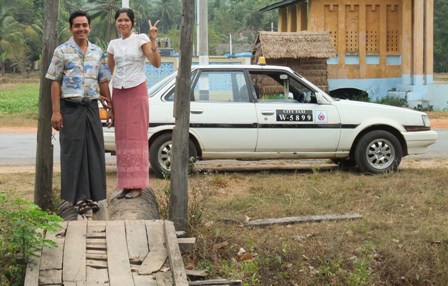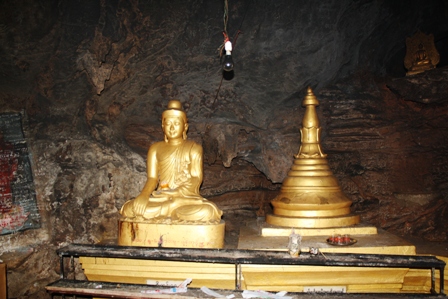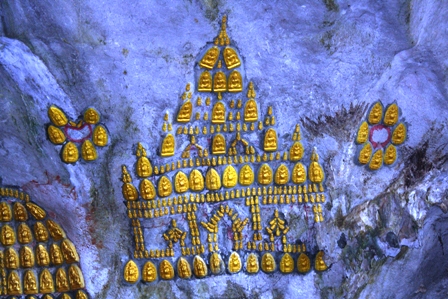
Click the photo above to see an album of photos. To return to our website close the window.
Read previous Bagan or next Delta Golden Rocks
Wednesday 20 January 2010 Hpa-An
We had just enough time for one last excursion in Myanmar. The area southeast of Yangon had been recommended as a less visited area full of temples, monasteries and caves. You can get there by public transportation but we would be limited in what we could see in the five days left before flying to Indonesia. The solution was to hire a car and driver for the trip.
Thant Zin and his wife of less than a year, Twinkle, AKA Thin Su Khine, picked us up on Tuesday morning, 18 January, at our Yangon hotel. Thant Zin’s full name is U Thant Zin Kwan, named for the much revered UN Secretary General U Thant, who died in 1974. They arrived in Thant Zin’s taxi, a 1985 Toyota Corona. The car has a right hand drive and you drive on the right side, as we do in North America, so Twinkle acted as his guide for safely passing cars. We wondered if the car would last long for the journey, but it did, just barely. Thant Zin rents the taxi from the taxi company and hopes one day to own his own, but new cars are even more expensive in Myanmar than they are in Canada. He told us a new cars cost at least $20,000, which is astronomical for Myanmar taxi drivers.
We had a long driving day ahead of us. We headed north out of Yangon on some of the best roads in the country, passing the six-lane highway leading to Nay Pyi Taw, the new capital of Myanmar. In 2005, after either consulting astrologers or perhaps fear of an Iraq-style invasion (take your pick), the Generals moved the capital to the middle of nowhere. It is still a wasteland as the populace has not followed. That is Myanmar for you!
Passing the ancient capital of Bago, which we would visit later, we headed south down the narrow strip of land that borders Thailand. We passed through green rice paddies, fields of watermelon and through rubber tree plantations. Eventually rocky Karst outcrops and mountains appeared on the landscape. These limestone formations are home to many cave temples. We visited our first one that afternoon. Called the Father and Brothers cave, it was named to commemorate two princes who, according to the legend, hid in the cave and were eventually murdered there.
The area outside the cave boasted multiple statues of legendary figures and three man-made pools fed by a stream. Two were bathing pools, one for men and the other for women. Perhaps they are cleaner when the streams are running at full strength during the rainy season but neither attracted us.
One thing we have learned in our travels in Myanmar is to wear sandals or shoes that can be easily removed. That is a requirement for entering all the temples, monasteries and any cave considered a religious site. That meant we walked through the cave in our bare feet. That is also the reason that you don’t get into bed at night without scrubbing your feet well.

Hpa-An, our stop for the night, is in Kayin State, the home of the fiercely independent Kayin people. There have been skirmishes with the government ever since Myanmar gained independence in 1948. A détente is in effect now, with the Kayin maintaining a measure of control in much of the northern and eastern part of the state. Thant Zin assured us there have not been any outbreaks of violence for quite a while but the men still tote rifles just in case. Many of the villages we passed had new wooden stilt houses, dated between 1995 and 2008. Perhaps this was a result of peace agreements between the Kayin and the government.
The next day we visited the local temple in Hpa-An on the banks of the Thantwin River. A popular eight hour boat ride on the river links the towns of Hpa-An and Mawlamyine but it only runs on Mondays and Fridays, so we took the roads instead. That way we got to visit some of Karst mountains along the way. Mt Zwagabin , at 2372 ft, is the tallest in the area. In the fields leading to its base are rows and rows of identical buddhas, 1150 in total. We passed up the two-hour hike to the summit and settled for a short walk to a view point.

We stopped for lunch at a small roadside restaurant. Thant Zin and Twinkle got into conversation with the owners who asked if we would like to see their Dancing Horses that perform for local festivals. At the back of the restaurant were four Albino ponies, each with tinkling bells on the sides of their heads. The Lippanzauer Horses of Austria have nothing on these little ponies. Two ponies with decorative halters were brought out and performed for us. They lifted their feet in rhythm and bowed low to us. One danced with her owner with her forelegs folded on his shoulders. We also had a demonstration of kick boxing. The owner faked some kicks until the horse knelt down in submission.
Soon we were on our way again, leaving Kayin State and entering Mon State, the home of the ancient Kings who once roamed as far as Bagan.